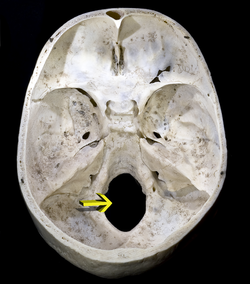Foramen Magnum

The function of the Foramen Magnum is to allow nerves, blood vessels and fluid to pass in and out of the brain. The Foramen Magnum is a large hole at the base of the skull. The Brain stem is essentially seated in the Foramen Magnum and lying on the basi-occiput. It can be subject to structural pressures that generate misalignment for a variety of different reasons.
The Foramen Magnum (Latin: great hole) is a large oval opening (foramen) in the occipital bone of the skull in humans and various other animals. It is one of the several oval or circular openings (foramina) in the base of the skull. The spinal cord, an extension of the Medulla Oblongata, passes through the foramen magnum as it exits the cranial cavity.
Apart from the transmission of the Medulla Oblongata and its membranes, the foramen magnum transmits the vertebral arteries, the anterior and posterior spinal arteries, the tectorial membranes and alar ligaments. It also transmits the spinal component of the accessory nerve into the skull.[1]
Atlas (Anatomy)

In anatomy, the atlas (C1) is the most superior (first) cervical vertebra of the spine. It is named for the Atlas of Greek mythology, because it supports the globe of the head which is the skull. The atlas is the topmost vertebra and with the axis forms the joint connecting the skull and spine. The atlas and axis are specialized to allow a greater range of motion than normal vertebrae. They are responsible for the nodding and rotation movements of the head.
The atlanto-occipital joint allows the head to nod up and down on the vertebral column. The dens acts as a pivot that allows the atlas and attached head to rotate on the axis, side to side. The atlas's chief peculiarity is that it has no body. It is ring-like and consists of an anterior and a posterior arch and two lateral masses. The atlas and axis are important neurologically because the brain stem extends down to the axis. [2]
C1 Atlas Vertebrae
Every organ associated with the meridians, namely Lung, Large Intestine, Stomach, Spleen, Heart, Small Intestine, Kidney, Pericardium, Triple Heater (endocrine system), Gallbladder and Liver, all have a direct or indirect neurological connection from the C1 (atlas) vertebrae with the exception of the Bladder. However one of the most significant points on the human body, BL10 is located directly over the atlas vertebrae and is where the Bladder meridian splits to form two distinct channels paravertebral down the spine to include the famous shu (associated) points. Therefore, all organ systems associated with the meridians are intimately related to the atlas vertebrae to include the Bladder due to this neurological connection.
Given the fact the Foramen Magnum (the opening at the base of the skull allowing the spinal cord to flow from the brain) can become partially occluded due to subluxation of the atlas vertebrae, which protects this area, it becomes obvious that this area is paramount for nerve flow through the body. Any disruption can cause extreme symptomatology and condition response. This is true for any neurological, visceral or musculoskeletal condition. [3]
Atlas Adjustment Technique
During the Ascension Cycle, some on the Awakening path of Kundalini activation have found relief of various intensified symptoms through Atlas Adjustment.
- Premise one: The "atlas activate and adjust" technique is a chiropractic procedure that reactivates or reconnects a dysfunctional or pathological body part's nervous system with the central nervous system via the master switch - the atlas vertebra.
- Premise two: On occasion, a body part's nervous system either partially or totally disconnects from the central nervous system below the level of the atlas, which requires this dysfunctional body part's nervous system to be reactivated to the central nervous system, before the subluxated atlas is adjusted.
- Premise three: Adjusting the subluxated atlas after reactivation reconnects the central nervous system with the dysfunctional body part's nervous system, which allows for the return of maximum adaptability or homeostasis.
- Premise four: This procedure activates the mind and body to connect the diseased or dysfunctional syndrome with the causative vertebral subluxation complex.[4]
Governor Vessel Correspondence
Governor Vessel is a typical example of the gap model of a channel. It originates in the Kidney, extends down to the perineum through the uterus or prostate gland, and then, one of the main branches ascends through the vertebral column. The point of GV-16 (Fong Fu) gives birth to the branch, which enters the scull. Its main pathway lies through the top of the head and ends at the upper lip.
What is an anatomical equivalent of the Governor Vessel: spinal chord or vertebral column? We believe that Governor Vessel is a vertebral channel and the point GV-16 (Fong Fu) corresponds to Foramen Magnum at the occipital bone. Therefore, the branch of Governor Vessel penetrating the skull is the extension of the vertebral channel into the skull through Foramen Magnum. [5][6]
References
- ↑ Foramen Magnum
- ↑ Atlas
- ↑ The Atlas Vertebrae
- ↑ Atlas Adjustment
- ↑ Medical Acupuncture
- ↑ Medical Acupuncture, Mikhail Teppone, Romen Avakyan

